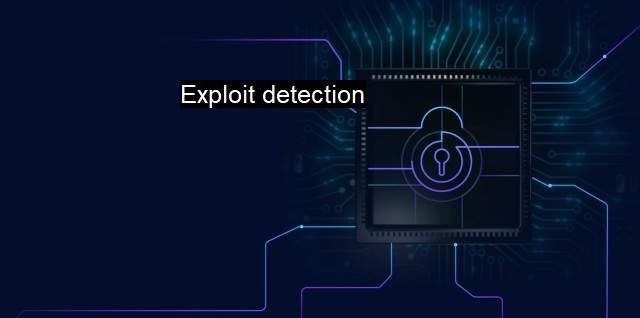What is Exploit detection?
Protecting Vital Data: Understanding Exploit Detection in Cybersecurity and IT Defense
Exploit detection is a critical aspect of cybersecurity and antivirus programs focused on identifying and countering attempts by unauthorized actors to exploit vulnerabilities in a network, system, or application. This process involves recognizing the specific patterns of misuse or anomalous behavior that typically indicate an exploit attempt.In the grand scheme of cybersecurity, exploits are malicious software or sequences of commands that take advantage of a specific weakness or vulnerability in a system, service, or application in order to gain unauthorized control over the operation or behaviour of the system bias to the violator’s end. In simpler terms, these can enable the violator to access, modify, or even control the host system without appropriate permissions or authority.
Exploit detection operates on the principle that all exploits behave or function in specific identifiable ways which can be characterized as patterns. These patterns are identifiable through meticulously programmed cybersecurity and antivirus software, which search for pattern matches in the data passing through the networks and systems which they safeguard.
The process behind exploit detection is complex and multifaceted. It typically involves the detection software constantly scanning the entries and exits of the protected network or system. This is coupled with consistent and comprehensive log monitoring and real-time network flow monitoring. By doing this, the detection software aims to instantly recognise and immediately act upon any exploits that are identified in order to limit the potential damage caused by a successful breach.
The value and importance of exploit detection measures in today’s cyber landscape cannot be overstressed, as it helps mitigate the potential risk and losses accruing from data breaches, identity theft, financial fraud, and even disruption in business continuity may occur, should sensitive systems overrun by unauthorised parties. It is integral to an organization's broader cybersecurity strategy, which often includes firewalls, intrusion detection systems (IDS), intrusion prevention systems (IPS), and antivirus software.
Despite the significance of exploit detection, it is not without challenges. First amongst these is that new types of exploits are continuously being developed and employed by malicious actors. To overcome this, exploit detection measures need to be constantly updated to incorporate the newest identified risk profiles and malicious activity patterns. There are also situations where an exploit does not match an existing signature in the virus or malware database; in such situations, it becomes harder for the system to identify and block these unknown threats. This aspect forms the basis for the development of heuristics-based exploit detection systems, designed to identify threats based on behaviours or properties that are similar to known or probable exploits.
Fundamentally, exploit detection software, which form an important part of antivirus programs, must remain dynamic in nature, being flexible and readily adaptable to the ever-evolving cybersecurity threatscape. This adaptability is the cornerstone of developing robust counter-strategies in realtime conditions.
Machine learning and artificial intelligence are increasingly being integrated into exploit detection systems. They bring anticipation and initiation into counter-hacking strategies by recognising potential threats that haven't been included in regular databases. Human intel paired with AI empowers the cybersecurity scene to adapt quicker to the constantly morphing vistas of digital threats.
Exploit detection serves as the frontline strategy for organizations to ward off cyber threats. It does not guarantee complete immunity to attacks but provides a protective layer that can stave off serious damage. Timely intervention by the exploit detection system when a potential exploit is discovered can essentially curtail the potential havoc that would have been wreaked on the system. As the cyber threat landscape continues to evolve, methods for exploit detection must also adapt, to provide the best defence in protecting system vulnerabilities and maintaining secure networks and systems.

Exploit detection FAQs
What is exploit detection?
Exploit detection is the process of identifying and analyzing software vulnerabilities and associated code that can be exploited by attackers to compromise a system's security. It is an essential component of cybersecurity that helps prevent malicious attacks and minimize damage.How does exploit detection work?
Exploit detection involves a range of techniques and tools that scan, analyze, and identify vulnerabilities in software or systems. These techniques can include network scanning, code reviews, vulnerability assessments, penetration testing, and behavioral analysis to detect and mitigate potential exploits.Why is exploit detection important for antivirus software?
Antivirus software relies on exploit detection to identify and block malware that exploits vulnerabilities in computer systems. By detecting and blocking these vulnerabilities, antivirus software can prevent malware from infecting systems and spreading to other devices in the network.What are the benefits of using exploit detection in cybersecurity?
Exploit detection can help organizations identify and mitigate potential vulnerabilities before they are exploited by attackers. This can minimize the risk of data breaches, theft, and other malicious cyber activities. By leveraging the latest exploit detection technologies and techniques, organizations can strengthen their cybersecurity posture and protect their assets from increasingly sophisticated threats.| | A | | | B | | | C | | | D | | | E | | | F | | | G | | | H | | | I | | | J | | | K | | | L | | | M | |
| | N | | | O | | | P | | | Q | | | R | | | S | | | T | | | U | | | V | | | W | | | X | | | Y | | | Z | |
| | 1 | | | 2 | | | 3 | | | 4 | | | 7 | | | 8 | | |||||||